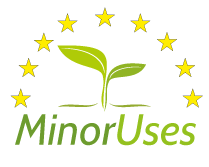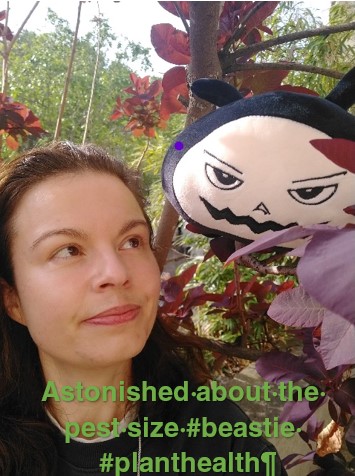|
|

MUCF Newsletter
n° 14 - June 2021
|
|
|
|
We are pleased to be circulating our first Newsletter for 2021 to provide you with an update about some of the interesting work we are doing.
The MUCF has taken some time to prepare this newsletter, as we wanted to gather as much information as possible and to involve our experts.
|
|

Barbara Edler / EPPO Beastie
Plant Health Year campaign
|
|
Welcome from the new co-ordinator:
Please let me introduce myself, for those of you who do not know me. My name is Barbara Edler, I was born in Austria and hold a degree from Department of Crop Protection of the University of Applied Life Sciences in Vienna and the University of Göttingen, Germany in agriculture with a focus on plant protection. I started the position as co-ordinator of the MUCF in October 2020, following on from Jeroen Meeussen, who together with EPPO and the MUCF team, did a notable job in establishing and running this facility over the past 5 years. I greatly look forward to collaborating in exchanging ideas and information with you about minor uses issues.
|
|
|
As stated on our website the MUCF is as an exchange platform for minor uses matters. Therefore, feel free to contact me or the team whenever you have a concern that has not yet been addressed by the Coordination Facility or to provide constructive input on our work mission.
But less about me, and back now to the news and updates in the world of minor uses.
Outline and quick links:
|
|
|

The Annual General Meeting for all Member Countries, involving the members of the Minor Uses Steering Group, the EU Commission, as well as the Director-General of EPPO was held on the 23rd of March 2021. The annual report and financial report of 2020 were approved and the work programme and budget for 2021 were presented.

The MUCF held the HEG and CEGs meetings by videoconference on several days in April 2021. All the meetings were very well attended. One of the positive outcomes of the fact that the expert groups were held online was the participation of experts in more than one working group. This might not have happened at classic face-to-face meetings due to scheduling conflicts. Many chairs noted that this led to an increase in participation and a lively exchange of solutions between experts.
This year were some changes in the Chairmanship and co-Chairmanship of the meetings. Ms Jana Johansen Hladilova from the Norwegian Food Safety Authority was appointed as the new Chair of the HEG. Ms Margarita Perez from the Spanish Mushroom Technical Center (ASOCHAMP) has been appointed as new Chair of the CEG Mushrooms and Ms Nancy Pyck from the Belgium Technical Center (INAGRO), and Ms Réjane Mazier from the European Mushrooms Growers (GEPC), were appointed as co-Chairs. Ms Claire Donkin from British Herbs, United Kingdom was appointed to chair the CEG Herbs and Spices and is supported by the co-Chairs Ms Gabriele Leinhos from Zentralverband Gartenbau e.V. (ZVG), Germany and Mr Hans van der Mheen (VNK BV) from the Netherlands.
|
|
|
To provide a small glimpse into the work done in the Commodity Expert Groups (CEGs) some Chairs agreed to report on their April 2021 meetings individually.

Florian Weihrauch (Chair) summarised the meeting on behalf of CEG Hops:
The EPPO Standard PP 1/239 (3) Dose expression for plant protection products was recently published and gives guidance on Leaf Wall Area (LWA) trial performance for crops including hops. As the new regional Standard for plant protection trials, the CEG members are concerned that the guidance is not well adapted for this specialty crop. After the full trellis height of 7 m has been reached, the biomass of the plants is still increasing considerably. Therefore, LWA has limitations in terms of being suitable for use to calculate a necessary maximum dose rate by the factor height alone. Following the meeting it was agreed that the CEG and the MUCF will provide information to the EPPO Secretariat PPP team to collaborate on this issue for future revisions.
In China, a new MRL regulation is being discussed, although it is still unclear whether the agricultural or environmental authorities will be ultimately responsible for this. So far, only a few MRLs have been set, which makes import and export problematic with regard to residues on hop cones. Strict residue testing is not usually carried out at present as this is not a priority for China, but this approach may likely change in the future.
The current EU Pesticide Review (16th April 2021) by Bryant Christie, Inc., lists a summary of the active ingredients of interest to the EU and US Hop Industries that are undergoing evaluation for reapproval through the EU Pesticide Review Process: For seven substances, registrants have not submitted the application for renewal of approval and approval has expired or will expire. Seven substances are now under consideration by the SCoPAFF and they are facing non-renewal or restricted renewal. For 16 substances, the Commission has published the final decision on non-renewal or restricted renewal in the EU. Relevant MRL changes were documented for four substances.
In view of this constant decrease of active substances which are important for the hop industry, two new or ongoing research projects concerning alternatives in plant protection were presented during the meeting. One project from the Czech Republic focuses on new possibilities of environmentally safe hop protection using basic substances and botanicals. In Germany, Systemic Acquired Resistance (SAR) of hops against spider mites will be investigated during the next five years as a potential new IPM module. It is relevant to note that the acreage of organic hops is increasing significantly (although at a low level) in the EU, especially in France (91 ha expected in 2023) and in Germany (approximately 250 ha expected in 2023).

Cyrille Thomas (Chair) summarised the meeting on behalf of CEG Rice:
The CEG Rice met with the participation of representatives from Hungary, Italy, Spain, Greece, France, as well as COPA-COGECA.
During the presentations of the situations in the different countries, weed management was confirmed to be the most problematic subject, due to:
- the presence of weed populations resistant to different groups of herbicides (ALS inhibitors, ACCase) in many areas.
- the withdrawals of active substances already in effect, or soon to take place (such as profoxydim in 2021) due to cut-off criteria.
In these conditions, the use of Article 53 Emergency authorizations appeared once again this year as necessary for rice producers in all the EU Member States. However, this situation creates disparities between producers from different Member States, and also between different producers from the same country (Authorizations may be differing between regions, i.e. Natura 2000 area, types of soil present, etc..).
It was agreed that the rice meeting participants should update the information concerning needs and potential solutions (short term needs have already been identified as well as long-term options) in order to identify common needs and solutions on which the CEG Rice could be involved.

Gea Bouwman (Chair) summarised the meeting on behalf of CEG Seeds:
Due to the ongoing Covid-19 situation the CEG Seeds met again by teleconference. However, as the famous Dutch football player Johan Cruijf used to say: "every disadvantage has its advantage". Although we sadly missed the personal face-to-face interaction of a physical meeting, we were happy to welcome 22 participants in our meeting, as well as 4 invited speakers. So, more people than usual were able to join the meeting, including experts from seed producing countries which had not participate in previous meetings of the CEG Seeds: hopefully this will contribute to further European collaboration on minor uses in seeds!
The 4 invited speakers from crop protection companies shared the latest developments on chemical and biological active ingredients in their portfolio for seed treatment and seed production. New products are very welcome, since more and more currently used active ingredients are losing their European approval, as illustrated by 2 CEG Seeds members. Since uses as seed treatment and in seed production are often (very) minor uses and authorisation processes are complicated, it is difficult to build good business cases for these applications. By cooperating, the MUCF, CEG Seeds and the crop protection industry hope to work on some solutions for our priority needs. For seed production the most important problems are fungal diseases especially mildew, insects such as aphids and beetles, weeds and growth regulation issues. There is a growing need for solutions for organic seed production. For seed treatment the CEG focuses on protection against soil diseases, aphids and flies in vegetables, ornamental crops and some arable crops. It was discussed with the MUCF how to include the CEG Seeds needs in a practical way in EUMUDA.
In a joint meeting with CEG Fruits & Vegetables, various trial results of seed and soil treatments against fungal diseases and for insect control in vegetables from 2020 were exchanged and plans for trials in 2021 were discussed.

Margarita Perez (Chair) summarised the meeting on behalf of CEG Mushrooms:
The CEG Mushrooms meeting was held with additional new members. 13 participants (not including the MUCF staff) from 8 Member Countries attended the meeting. The focus was on the following subjects: controlling cobweb disease, residues potentially found in cultivated mushrooms originating from the straw used to produce growing compost and EU co-funded research projects involving mushrooms. The MUCF informed our CEG group about several other developments, such as the new website. The MUCF's presentation on the distribution of information on solved needs was highly appreciated by the CEG Mushrooms participants.
All in all, we had very fruitful meetings with interesting outcomes. More information can be found on our restructured MUCF website. I invite you to have a look here, many pages have been updated.
|
|
|

The MUCF hopes to organize and host the CEGs and HEG meeting again in person in Brussels in Autumn 2021-10-20/22. For more updates about the upcoming meetings (where, when and how they will be held) please refer to our website under: https://minoruses.eu/mucf/meetings
|
|
|

José-Luis Alonso-Prados from the National Institute for Agricultural and Food Research and Technology/Plant Protection Products Unit, Madrid, Spain (INIA-CSIC) contributed the following article for the newsletter as an action point arising from the HEG meeting.
Extrapolation of residue data from major to minor crops, a challenge for minor crops.
Maximum residue levels (MRLs) for pesticides on food and feed of plant and animal origin are established to guarantee consumer safety and to regulate international trade. At a global level, the Codex Alimentarius Commission, created in 1963 by FAO and WHO, sets MRL recommendations worldwide that are not mandatory, but aim to improve international trade. In the Europe Union, Commission Regulation (EC) No. 396/2005 was adopted to unify European legislation, to ensure safe food consumption and to avoid differences in MRLs for pesticides between Member States that could involve barriers to trade.
Availability of plant protection products to be used on minor crops is usually limited, compromising the implementation of adequate pest and disease management programs. The main limitation for the registration of plant protection products for minor crops is the establishment of MRLs, an essential requirement according to Regulation (EC) No 1107/2009. The setting of MRLs involves the development of supervised field residue trials that make the cost/benefit unfavourable for these crops. According to EU guidance SANTE/2019/12752, this situation could be solved via the adoption of extrapolations from results of residue trails from a surrogate major crop to a minor crop using data from field trials performed on the major crop with pesticides used in both crops.
Extrapolation Guidance Document (SANCO 7525/VI/95 Rev 10.3) that includes guidance on data requirements for setting maximum residue levels, comparability of residue trials and extrapolation of residue data on products from plant and animal origin, has been recently reviewed by the EU Commission. On November 23, 2020 the SCoPAFF Committee took note of the Technical Guidelines on SANTE/2019/12752. This revision was made to align the existing guidance document with the OECD Guidance document on crop field trials and with other OECD guidelines for testing of chemicals. In addition, the Technical Guidelines incorporated elements from the EFSA document on residue trials and MRL calculations and the Guidance document for the design, preparation and execution of residue trials. Table 3 of the guidance SANTE/2019/12752 contains the recommended extrapolation of residue data though not many extrapolations from major to minor crops are included.
Residue trials have to be performed based on the critical Good Agriculture Practice (GAP) and take into consideration whether the crop is cultivated under protected conditions or under field conditions. Residue field trials should be representative of the zones where an EU authorization is granted. With regard to the pesticide residue assessment, the EU is divided into two geographical zones that are considered to represent comparable conditions.
The new version of the guidance document has clarified issues related to the number of residue trials necessary for each geographical zone. The minimum number of trials varies between 4 independent trials per residue zone for a minor crop and 8 independent trials per zone for a major crop. In certain specific circumstances a reduction in the number of trials is acceptable. In particular, for minor crops and according to Regulation (EU) No 283/2013, if the GAP is the same in both residue zones, 6 trials equally distributed in the representative growing zones would be enough for a minor crop. Special attention is given to the acceptance of residue trails performed outside the EU, this is especially important for minor crops, in particular for supporting tropical minor crops or minor crops not covered by extrapolations.
Furthermore, several minor crops are cultivated under protected conditions. The new version of the guidance document includes provisions related to the number of residue trails for indoor uses. In addition, different types of protected structures in the field are recognised. However, for performing residue trials it is stated that uses on crops cultivated from planting to harvest in a completely enclosed structure (i.e. greenhouses, glasshouse) are considered as indoor/greenhouse GAPs. Therefore, structures that are not completely enclosed (i.e. net shelters, shade houses) are considered as outdoor GAPs.
The revision of the guidance document was mainly focused on the text, while the tables were not within the scope of the exercise and were not reviewed in detail. The REFIT Report (REFIT is a rolling programme to keep the entire stock of EU legislation under review and ensure that it is 'fit for purpose'), that is one of the supporting documents of the Farm to Fork strategy, stated that EU Commission will continue to regularly update the existing Extrapolation Guidelines for MRLs to facilitate MRL setting for minor crops. This issue reinforces the idea that Table 3 of the guidance document should be a dynamic table open for amendments and modifications in order to facilitate the inclusion of extrapolations, especially in favour of setting MRLs in minor crops. Further projects should be implemented to generate residue data to justify extrapolations of residue data from major to minor crops.
|
|
|

Last but not least we would like to inform you that we have an open vacancy for a Technical Research Intern to join us for 3 months from the 15th of September. Please feel free to circulate this information to relevant persons.
More information about the offer can be found under:
https://minoruses.eu/jobs/internship
Applications must be received before midday 12:00 (Paris time) on Tuesday 21st June 2021.
|
|
|
Stay safe!

The MUCF Team
|
|
|
|
|
